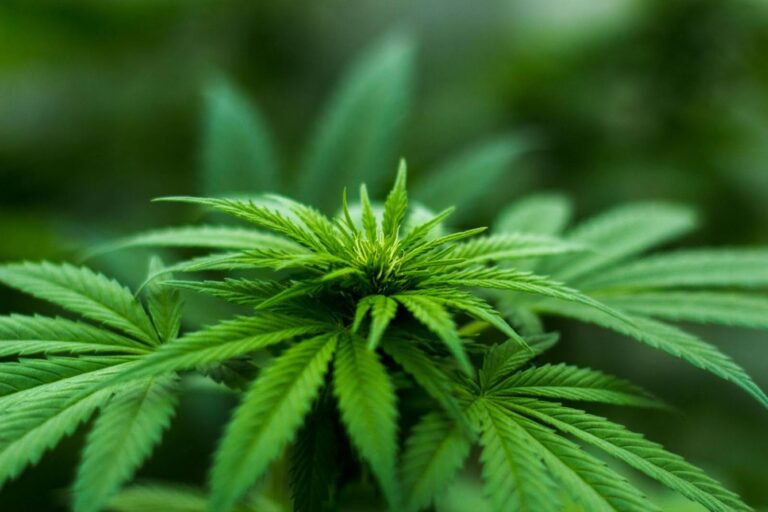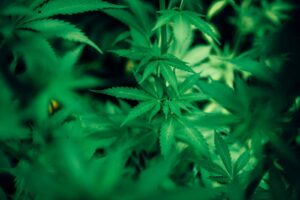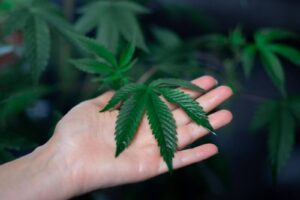You might have often found yourself doubting the water level that your cannabis plants should have in their vegetative stage. Getting it right is one of the most critical things about growing.
Too much water will cause suffocation on the roots and cause mold and fungi problems. The roots get a nutrient lockout from excess water. The opposite of too much water can slow down the growth of your plants, make them weaker in structure, and thus prone to stress and diseases.
Understanding how, when, and how much to water your cannabis plants during this stage is essential for their development. Proper hydration ensures that the roots grow strong, the plant absorbs nutrients effectively, and sets the foundation for a high-yielding flowering stage.
This guide examines how to water a cannabis plant during its vegetative cycle. We’ll learn about the frequency of watering, how to determine whether a plant requires water, methods of watering, and environmental influences on watering. We’ll also discuss diagnosing thirsty plants and common watering mistakes.
Watering Frequency in the Cannabis Vegetative Stage
During the vegetative stage, your cannabis plants require a steady but not excessive amount of water to support their rapid growth and overall health. Watering every two to four days is a general guideline, but this can vary widely depending on several factors. Ensuring the right amount of water allows for strong root expansion, proper nutrient uptake, and resilience against environmental stress. To determine the ideal watering schedule for your plants, consider the following factors:
- Pot Size: Larger pots retain moisture longer, while smaller pots dry out more quickly.
- Soil Type: Well-aerated soil drains faster, requiring more frequent watering, whereas dense soil retains moisture longer.
- Environmental Conditions: Temperature, humidity, and air circulation influence how quickly the soil dries out.
- Growth Stage: Younger plants may require less frequent watering than well-established plants with more extensive root systems.
- Drainage and Aeration: Well-drained containers prevent the risk of overwatering while ensuring that sufficient oxygen reaches the roots.
- Mulching: The application of mulch on the topsoil allows for moisture retention, reducing the need to water as often.
- Rooting: Plants with deeper root structures can access the moisture better with less frequent watering.
- Container Material: Although fabric pots provide more aeration and faster drying than plastic, they influence how often one will water.
Oxygen starvation will likely result if the soil remains too wet for an extended period, causing root rot and fungal problems. On the other hand, extended dry spells may retard growth and increase stress and nutrient deficiency susceptibility in plants.
Now, let us understand how to determine your cannabis plant’s water needs.
Determining Cannabis Water Needs
Knowing how much water a hemp plant needs daily can be tricky, but several simple techniques can help ensure optimal hydration. Understanding water needs is essential for avoiding common problems like underwatering and overwatering, which can stunt growth and reduce yields. Below are some practical methods for effectively assessing your plant’s water requirements.
- Finger Test: Insert your finger about two inches into the soil. If your plant feels dry at that depth, it is ready for water. If it is still moist, hold off and check again later.
- Soil Moisture Meter: Use a soil moisture meter for a more precise approach. This tool provides an accurate reading of soil hydration, removing guesswork from the process.
- Pot Weight Method: A dry pot weighs much less than a well-watered one. By lifting the pot before and after watering, you can sense when the soil is drying out and when the plant needs more hydration. This method is quite effective for growers using fabric or plastic pots.
- Runoff Monitoring: When watering, observe how quickly runoff occurs. If water runs off immediately, the soil may be too dry and not absorb moisture effectively. If it pools excessively, the soil might already be saturated.
- Leaf Behavior: Plants with adequate water will have firm, upright leaves. Wilting or drooping leaves can indicate dehydration, while overly swollen, dark green, or yellowing leaves may suggest overwatering.
- Soil Color and Texture: If the soil is damp and dark, it has enough water. On the other hand, dry, light in color, and crumbly soil requires more water.
Are you curious about early problem detection in your cannabis yield? PlanaCan removes the guesswork from soil monitoring. For example, fast runoff may indicate dry soil, while pooling suggests saturation. PlanaCan tracks all data, refining your methods for higher yields and profits.
So, what are some effective watering techniques for cannabis? Let us discuss.
Effective Watering Techniques For Cannabis
How you deliver water is just as important as how often. Proper watering techniques ensure plants receive moisture efficiently without causing stress or damage. Below are some effective methods for watering cannabis plants during the vegetative stage:
1. Hand Watering
Hand watering is labor-intensive, but it allows for more control over the amount of water each plant receives. It is ideal for small-scale growth or when plants require individual attention.
- Accurate Distribution: Ensures that water is distributed evenly and does not overwater or underwater specific areas.
- How to Use: Use a watering can or hose with a fine spray nozzle to water plants directly. Water slowly to ensure even absorption and avoid runoff.
- Best Practice: Monitor plant health closely during watering to spot potential issues like nutrient deficiencies or pests.
Ideal For: Small-scale grows or individual plants that need personal attention.
2. Drip Irrigation
Drip irrigation is an automated watering system that delivers water directly to the root zone at a controlled rate. This method is very efficient, saving much water and decreasing the chance of disease.
- Water Efficiency: Gradual water release that minimizes runoff and maintains uniform watering.
- How to Use: Set up an automated system with adjustable timers and emitters that deliver water directly to the root zone.
- Best Practice: Program the system to match the water needs of your plants, adjusting for changes in growth stage and environmental factors.
Ideal For: Medium to large grow, commercial use, and saving water techniques
3. Bottom Watering
Bottom watering involves putting the pots in a tray with water so that moisture can enter them through the drainage holes. This helps encourage deep root growth and eliminates overwatering from the top.
- Promotes Root Strength: Helps to develop roots since plants search for water from the bottom.
- How to Use: Place pots in a shallow water tray to allow the moisture to enter the drainage holes.
- Best Practice: Remove excess water after absorption to prevent root rot.
Ideal For: Seedlings, young plants, or small container-grown plants that benefit from deep root growth.
4. Misting and Foliar Feeding
Misting delivers water directly to the leaves; it is sometimes useful for managing humidity and limited nutrient uptake
- Humidity Booster: Maintains optimal moisture conditions in dry spaces.
- How to Use: Mist the leaves directly with water or a nutrient solution to improve humidity and nutrient absorption.
- Best Practice: Use a mist-style sprayer for even coverage. Avoid misting in high-humidity areas to prevent mold growth.
- Ideal For: Seedlings, plants in dry conditions, and for providing rapid nutrient uptake.
Ideal For: Seedlings, plants under dry conditions, nutrient enhancement
5. Deep Watering
Deep watering saturates the soil until water penetrates the deeper zones of the root, prompting the plants to grow more potent and spread further.
- Promotes Stronger Roots: Roots would grow downward to anchor better and grab more nutrients in the soil.
- How to Use: Water infrequently but with larger amounts to saturate the soil deeply, encouraging roots to grow downwards.
- Best Practice: Water once the top inch of soil is dry, but ensure the water reaches deeper root zones.
- Ideal For: Outdoor plants, larger pots, and plants needing long-term hydration.
Ideal For: Outdoor plants, bigger pots, and long-term hydration.
6. Wick Watering System
A wick watering system has a wick material that will draw water up from a reservoir into the soil, thus constantly hydrating it.
- Self-Watering Mechanism: Continuously maintains its moisture level while infrequently developing waterlogged conditions.
- How to Use: Use absorbent wick material, such as cotton rope, to continuously draw water from a reservoir into the soil.
- Best Practice: Keep the water reservoir clean to avoid algae or mold growth.
- Ideal For: For growing plants indoors or for hydroponic systems. Also, for less maintenance, grow setups.
Selecting the optimal watering method for your grow setup optimizes hydration, maintains healthy conditions, and reduces waste. PlanaCan streamlines this by automating task scheduling. Growers can create customizable templates for each stage, from planting to harvest, and easily schedule tasks for a consistent, efficient workflow.
Now, let us understand the factors that influence cannabis watering.
Environmental Factors Influencing Cannabis Watering
Environmental factors determine how much and how often cannabis plants need water. Temperature, humidity, light intensity, and air circulation affect soil moisture retention and hydration. However, seasonal changes, plant maturity, and the growing medium influence the watering frequency, helping growers avoid overwatering or underwatering.
1. Temperature
- High Temperatures: Increase evaporation, causing soil to dry out faster and requiring more frequent watering.
- Low Temperatures: Slow plant metabolism and reduce water uptake, meaning less frequent watering is needed.
Tip: Water early or late evening to prevent excessive evaporation during hot weather.
2. Humidity
- High Humidity: Slows evaporation, allowing soil to retain moisture for longer.
- Low Humidity: Speeds up moisture loss, increasing the need for frequent watering.
Tip: Monitor humidity levels using a hygrometer and adjust watering frequency based on humidity conditions.
3. Light Intensity
- Strong Light Exposure: Increases transpiration, causing plants to lose water faster.
- Low Light Exposure: Reduces water usage, leading to slower soil drying.
Tip: Consider light exposure when adjusting your watering schedule, especially in indoor growing setups with artificial lighting.
4. Air Circulation
- Strong Airflow: Enhances evaporation and can lead to quicker soil drying.
- Poor Air Circulation: Reduces evaporation, potentially leading to overwatering issues.
Tip: Ensure proper ventilation in growing spaces to balance moisture retention and evaporation.
5. Seasonal Changes
- Summer: Higher temperatures and increased light exposure require more frequent watering.
- Winter: Lower temperatures and humidity levels reduce watering needs.
Tip: Adjust your watering routine for seasonal variations to keep plants healthy. Use PlanaCan to automate task scheduling with customizable templates, streamlining your workflow from planting to harvest for consistent care and efficiency.
6. Plant Growth Stage
- Younger Plants: Require less water as their root systems are still developing.
- Mature Plants: Need more water due to their larger root mass and increased nutrient uptake.
- Best Practices: Adapt watering frequency to match the plant’s growth stage.
Understanding these environmental factors and making necessary adjustments can create an optimal watering routine that promotes healthy and vigorous cannabis plants.
So, how do you identify thirst in your cannabis plants? Here is how you can do that.
Identifying Thirsty Cannabis Plants
Even with a proper watering schedule, plants will still show signs that indicate their water status. Various visual and tactile cues will help determine whether your plants need water. It is important to be observant. Below are some of the key indicators to watch out for:
1. Drooping Leaves
- Underwatering: Leaves become weak, limp, and may appear thin or slightly curled.
- Overwatering: Leaves may droop but feel heavy and swollen due to excess water retention.
Best Practices: Always check the soil before watering; if it’s dry a few inches below the surface, it’s time to hydrate.
2. Leaf Texture and Color Changes
- Underwatered Plants: Leaves become brittle and dry and may develop brown edges or spots.
- Overwatered Plants: Leaves turn yellow, feel overly soft, and may start curling downwards.
Best Practices: Observe changes in leaf appearance and adjust watering as needed. PlanaCan tracks all cultivation decisions and harvest data, helping you analyze trends, identify successful methods, and refine your approach for higher yields and improved profitability.
3. Soil Condition
- Dry Soil: If the top few inches of soil feel dry and crumbly, your plant likely needs water.
- Soggy Soil: Overwatering could be an issue if the soil remains wet for long periods and has a slight odor.
- Compacted Soil: Soil that feels hard and does not absorb water quickly may indicate a lack of moisture or poor aeration.
Best Practices: Use a soil moisture meter to ensure proper hydration levels and aerate the soil as needed.
4. Slow Growth or Wilting
- Underwatered Plants: Growth slows down, leaves look thin and lack vibrancy.
- Overwatered Plants: Excess moisture in the root zone may cause fungal infections and stunt plant development.
Best Practices: Maintain an optimal watering schedule and ensure proper drainage.
5. Root Health and Development
- Underwatering Effects: Roots may appear dry, brittle, or underdeveloped due to insufficient hydration.
- Overwatering Effects: Root rot may develop, leading to blackened, mushy roots and poor nutrient uptake.
Best Practices: Inspect roots periodically, especially in container plants, to ensure they are healthy and free from excess moisture buildup.
6. Weight of the Pot
- Lightweight Pot: Indicates that the soil has dried out and needs watering.
- Heavy Pot: Suggests that the soil is still moist and does not require immediate watering.
Best Practices: Compare pot weight before and after watering to establish a baseline for when to water.
Conclusion
Mastering watering during the vegetative stage requires observation and adaptability. Instead of following a rigid schedule, practical methods such as the finger test, soil moisture meters, and pot weight comparisons can determine when and how much to water. Environmental factors like temperature, humidity, and airflow greatly affect the water needed, so continuous monitoring and adjustments are essential for optimal plant health.
PlanaCan offers powerful tools to maximize yields and streamline cannabis cultivation. With customizable templates, you can define and automate your entire cultivation cycle, ensuring each step from planting to harvesting is efficiently scheduled for consistency across strains and harvest cycles. It also provides a clear visual timeline to manage daily tasks while planning months in advance.
In addition to its strong scheduling capabilities, PlanaCan integrates real-time data tracking and analytics to monitor plant health, growth conditions, and overall crop performance. This data-driven approach allows cultivators to make informed decisions, optimize resources, and address potential issues before they affect the harvest.
Schedule a free call today to find out how PlanaCan can help you manage your cannabis crops better!




